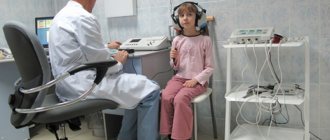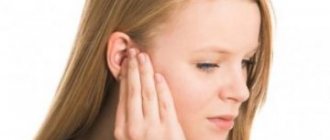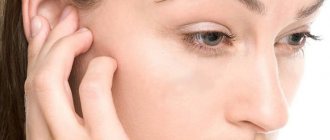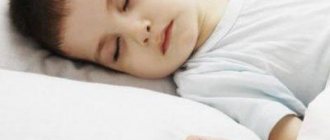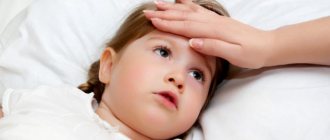Conductive hearing loss is a hearing disorder characterized by difficulty transmitting sound waves to the sound-receiving apparatus. The main clinical signs are decreased hearing acuity, “stuffy” ears, increased perception of one’s own voice, deterioration in differentiation of speech from surrounding noise. Diagnostics includes analysis of anamnestic information, complaints, otoscopy data, audiometry, Rinne and Weber tests, and tympanometry. Therapeutic tactics depend on the etiopathogenetic form of the disease and may include both drug and surgical treatment.
Conductive hearing loss
Conductive hearing loss is a widespread pathology in otolaryngology, which is associated with the presence of a large number of etiological factors. In the general structure of the disease, about 67% of cases arise as a result of lesions of the Eustachian tube, auditory canal or tympanic cavity. In 2.1% of cases, the pathology is accompanied by irreversible changes in the sound-conducting system. The disease is more common in older age groups. According to statistics, children get sick 13 times less often than adults. In males and females, this pathological condition occurs with equal frequency.
Causes of conductive hearing loss
The main causes of this form of hearing loss are impaired conduction of the sound signal from the outer ear to the sound-receiving apparatus. This occurs as a result of distortion of sound waves as they pass through the outer and middle ear, endolymphatic space and cochlear membranes, which can be caused by the following etiological factors:
- Impaired patency of the external ear . Ear wax, foreign bodies, tumors, otitis externa, swimmer's ear, exostoses, traumatic injuries and congenital auditory atresia worsen or make it impossible for sound vibrations to travel to the eardrum.
- Damage to the eardrum . These include: perforation due to acute acoustic trauma, tympanosclerosis, sudden changes in atmospheric pressure (during a rapid climb or descent). Violation of the integrity of the tympanic septum makes it difficult to transmit mechanical vibrations to the auditory ossicles.
- Damage to the middle ear. Exudative and purulent otitis media, otosclerosis, tubootitis, cholesteatoma, blockage of the pharyngeal opening of the Eustachian tube by adenoid vegetations or other pathological structures are accompanied by impaired mobility and conductive function of the auditory ossicles.
- Diseases of the inner ear . Obstruction of the round or oval window of the cochlea and digiscence of the anterior semicircular canal can interfere with the normal movement of the endolymph, which transmits vibrations to the organ of Corti.
Pathogenesis
The pathogenesis of conductive hearing loss is based on dysfunction of the sound-conducting system - the external auditory canal, eardrum, middle ear cavity and auditory ossicles, endolymph or cochlear membranes. Normally, all these structures are responsible for amplifying and transmitting sound to the structures of the sound perception system. Violation of at least one link in this chain leads to distortion of vibrations and general deterioration of hearing. The function of the organ of Corti, the auditory nerve and the posterior parts of the superior temporal gyrus, which are responsible for the perception and processing of what is heard, is not impaired. Due to this, patients maintain normal bone conduction of sounds. In severe cases, its sensitivity exceeds air sensitivity, which is why a person fully perceives only his own speech.
Treatment of mixed hearing loss
Treatment of mixed hearing loss is aimed at eliminating the underlying causes and restoring the quality of hearing. For this purpose, a course of medications, physiotherapy or surgery is prescribed.
Drug treatment
It is permissible to treat the disease at the initial stage of development with the help of medications.
The therapeutic course lasts 14 days and includes intramuscular injections and oral medications.
The following medications are used during treatment:
- antibiotics to relieve symptoms of mixed hearing loss of infectious and inflammatory origin;
- antihistamines to relieve swelling and inflammation;
- B vitamins, which are necessary for the normal functioning of the hearing aid and speeding up the healing process;
- means for restoring normal blood flow in the cranial area, which improves the functioning of the ear and auditory center in the brain.
Physiotherapy
Mixed hearing loss can be easily corrected using physiotherapeutic procedures, namely:
- electrical stimulation of the brain stem with pulsed current;
- blowing the ear during inflammation;
- pneumomassage - exposure of the drum membrane to air at various pressures;
- hyperbaric oxygenation – inhalation of air enriched with oxygen, which helps accelerate the regeneration of damaged cellular structures.
Surgery
Treatment of mixed hearing loss is carried out promptly only if there are indications:
- lack of effectiveness of conservative therapy;
- bilateral mixed hearing loss of degree 2 or higher;
- unilateral mixed hearing loss of 3 and 4 degrees.
Mixed hearing loss can be cured using the following methods:
- myringoplasty, which involves the installation of a synthetic implant that can replace a damaged eardrum.
- ossiculoplasty is prescribed for dysfunction of the auditory ossicles;
- Cochlear implantation is a modern method of combating hearing loss using an implant that improves bone conduction and the brain stem.
A hearing aid is one of the methods of hearing restoration, which is often used for bilateral mixed hearing loss of the 3rd degree or unilateral form of the 4th degree. The choice of a sound amplification device is based on individual characteristics and audiometric results.
Classification
Depending on the severity of hearing impairment, there are 4 degrees of severity of conductive hearing loss:
- I degree . A person is able to perceive whispered speech at a distance of up to 3 meters, conversational speech - up to 15 m. Distorted speech or conversation in conditions of external noise is not perceived at all. The tonal threshold is in the range of 20-40 decibels.
- II Art. The patient can understand a whisper at a distance of up to 1 meter, a normal conversation - up to 5 m. Speech intelligibility sharply deteriorates under normal conditions. Sounds with a volume of at least 40-60 dB are normally perceived.
- III Art. Characterized by the ability to perceive spoken language from a distance of no more than 2 meters. Whispers and sounds below 50-70 dB are not distinguished.
- IV Art. The patient loses the ability to recognize human speech without assistive hearing devices. The tonal threshold is 70 dB or more.
Classification and degrees of development of mixed hearing loss
Types of mixed hearing loss depending on the extent of the lesion:
- Unilateral mixed hearing loss is characterized by damage to one ear canal on the left or right side, while the pathology does not affect the second ear. However, this form of the disease significantly worsens the quality of life, since at a great distance people are not able to perceive speech or communicate in a noisy room.
- Bilateral mixed hearing loss - the disease simultaneously affects the hearing aid on both sides, while hearing loss has varying degrees of severity. Bilateral mixed hearing loss significantly worsens the patient's quality of life, complicates social adaptation and can cause complete deafness.
Types of mixed hearing loss according to the localization of the pathological process: conductive and sensorineural mixed hearing loss. The first type develops under the influence of traumatic and infectious factors, which lead to damage to the connecting membrane or auditory ossicles in the middle ear. Thanks to medical advances, this form can be corrected.
Mixed sensorineural hearing loss is characterized by a decrease in the number of hair cells in the cochlea, which are responsible for the perception and transmission of sound impulses. Occurs due to infection, autoimmune pathologies or allergic reactions. As a rule, it is difficult to treat with medication.
Types of mixed hearing loss according to the degree of hearing loss:
- Mixed hearing loss of 1st degree is the mildest. The patient is able to differentiate conversational speech with a strength of more than 40 dB at a distance of more than 3 m. Whispers are recognized at a distance of no more than 1 m.
- Mixed hearing loss of the 2nd degree is characterized by an increase in the hearing threshold, which the patient is able to recognize - from 55 dB. At the same time, a person ceases to perceive quiet speech and whispers, and when talking in normal tones, the distance between the interlocutors should not be more than 3 m.
- Mixed hearing loss of the 3rd degree leads to the patient’s inability to differentiate normal speech. The sound intensity threshold starts at 70 dB - the hearing aid perceives only loud sounds.
- Mixed hearing loss of the 4th degree or complete deafness - the patient hears sounds with a force of 90 dB, which corresponds to a loud scream, rumbles of thunder, etc. All sounds below this threshold are not perceived by the hearing aid.
According to the nature of the course, mixed hearing loss can be sudden, acute and chronic. The mixed type of hearing loss of the first form is a sudden disruption of the functioning of the sound-receiving apparatus (within several hours) under the influence of viruses, traumatic factors, tumors or a sudden disruption of blood flow to the ear labyrinth.
Acute mixed hearing loss is characterized by a sudden onset and rapid development over several days. Chronic mixed hearing loss – hearing loss occurs gradually over several months.
Symptoms of conductive hearing loss
The main symptom is a gradual or sudden loss of hearing acuity. This is manifested by a deterioration in the perception of spoken and whispered speech, and the inability to differentiate the words of the interlocutor from external noise. One of the characteristic clinical manifestations is a feeling of “stuffiness” in the ears. Patients describe this condition as “ears plugged with fingers or earplugs.” In this case, a person perceives his own voice louder than surrounding sounds. Various etiological forms of hearing impairment can lead to both unilateral and bilateral damage. With the development of hearing loss against the background of inflammatory diseases (otitis externa and media, tubo-otitis, etc.), hearing loss is accompanied by an increase in body temperature, pain in the ear, which intensifies with sneezing or chewing. As a rule, after full treatment, hearing is fully or partially restored.
Types of hearing loss
Depending on the cause of damage to the ear canal, it is customary to distinguish the following types of hearing loss: sensorineural, conductive, sudden deafness and mixed hearing loss. Mixed hearing loss combines sensorineural and conductive hearing loss.
Sensorineural hearing loss develops due to the death of hair cells in the cochlea, which are responsible for the perception of sounds. This result is caused by many diseases caused by bacteria and viruses, as well as allergic and autoimmune diseases. Sometimes the disease is caused by drug therapy. In the vast majority of cases, this is an irreversible process.
Conductive hearing loss develops as a result of acute, external or chronic otitis media. The cause may also be the formation of cerumen plug or damage to the eardrum. In medical practice, there are cases of the development of conductive hearing loss against the background of congenital structural pathologies, tumors of the auditory canal, and as a result of injuries. With medication or, if necessary, surgical treatment, the disease can be completely cured.
Complications
The development of complications of conductive hearing loss is determined by the etiology and duration of the disease. In most cases, they are associated with the transition of inflammatory diseases into chronic forms, which lead to repeated lesions of the sound-conducting system. In some cases, pathological processes spread to regional anatomical structures. Damage to the temporomandibular joint leads to its dysfunction, which is manifested by increased ear pain when chewing and talking. When the inner ear, auditory nerve or meninges are involved in the process, the function of the sound-receiving apparatus is disrupted, sensorineural hearing loss and persistent hearing loss develop.
Diagnostics
Diagnosis of the conductive form of hearing impairment consists of determining the cause of the disease, an objective and instrumental study of the sound conducting system of the ear. An important role is played by the correct collection of anamnesis: clarification of previously suffered diseases, injuries, etc. To make a diagnosis, the following is carried out:
- Otoscopy. An objective examination of the outer ear reveals inflammatory or structural changes in the ear canal, the presence of wax plugs or a foreign body. This method also allows you to study the structure of the eardrum and identify its protrusions, retraction pockets, hyperemia or perforation.
- Tuning fork tests (Rinne, Weber). With conductive hearing loss, the sound of a tuning fork is perceived louder when it is located on the mastoid process than near the auricle. During the Weber test, a sounding tuning fork is placed on the parietal part of the head along the midline. With unilateral conductive hearing loss, the sounds of a tuning fork are perceived more strongly on the affected side.
- Audiometry. Allows you to identify a progressive decrease in the air conductivity curve, provided that the normal function of the sound-receiving apparatus is maintained.
- Tympanometry. Displays the increase in acoustic impedance in the middle ear. This is evidenced by a more intense reflection of sound. The test is most informative in case of damage to the middle ear with the release of a large amount of transudate.
- Radiation diagnostic methods. X-ray of the temporal bones, CT and MRI of this area are used when the information content of all the above-mentioned research methods is low. These techniques make it possible to identify abnormalities in the structure of the auditory canal, middle and inner ear, and accurately determine the cause and form of hearing loss.
Differential diagnosis is carried out with the sensorineural form of hearing loss. The main diagnostic criteria are the results of audiometry, Rinne and Weber tests. In contrast to conductive hearing loss, the audiogram will show deterioration in both bone and air conduction. In the Rinne test, sound is perceived better when the tuning fork is positioned opposite the auricle. When performing the Weber test, the sound of a tuning fork is heard better from the healthy ear.
Characteristic features of hearing impairment in conductive hearing loss.
Characteristic features of hearing impairment in conductive hearing loss.
In case of disturbance of sound conduction function
, auditory thresholds for air conduction are increased mainly at low frequencies, auditory thresholds for high frequencies often remain normal, as do auditory thresholds for bone conduction.
In this case, the air conduction curve has an ascending character,
since the thresholds are increased, or hearing is reduced mainly at low frequencies.
The resulting gap between the air and bone conduction curves is called cochlear reserve
, and indicates the preservation of the sound perception function when the sound conduction function is damaged.
This hearing loss is called bass or
conductive hearing loss.
Fig. 52 Audiogram with conductive hearing loss, or conductive hearing loss.
With the conductive nature of hearing loss, bone conduction of sound is not impaired.
The conduction of sound through the bone is carried out by the bones of the pyramid, which begin to vibrate, and this is easy to verify if you place a vibrating tuning fork or an iron plate vibrating under the action of a sound wave on the mastoid process. This sound conduction is called bone conduction; it is used in hearing research, since it provides additional information to resolve the issue of the nature of the hearing impairment. Bone conduction of sound occurs in every hearing person during speaking and singing, when the vibration of the facial bones is transmitted to the pyramid of the temporal bone and the bone capsule of the inner ear. The mechanism of bone sound conduction is associated with vibration of the bone capsule of the inner ear, which is transmitted to the perilymph of the vestibular and scala tympani of the cochlea, bypassing the middle ear, and causes deviations of the main membrane of the cochlear duct, together with the hair cells located on it.
Good bone conduction always indicates the preserved function of the hair cells of the spiral organ, and when examining hearing, the diagnosis of damage to sound conduction and sound perception is based on the characteristics of air and bone conduction. If conduction hearing is impaired, sounds are perceived better through bone than through air. In this regard, a normal level of bone conduction is also an indicator of the preservation of the function of the inner ear. Bone conduction partly depends on the condition of the labyrinthine windows.
We hear our own voice using air and bone conduction, and thanks to bone conduction we hear low-frequency sounds produced by the vocal folds, and therefore our voice seems stronger and deeper to us compared to how others hear it, or records .
Characteristic features of hearing impairment in sensorineural hearing loss.
For sensorineural
Hearing loss is characterized by increased hearing thresholds, both in sound conduction and in bone conduction, mainly at high frequencies, which is associated with
a descending
configuration of the auditory curves. In this case, the air and bone conduction curves are located side by side, without a gap between them, that is, a decrease in air conduction hearing corresponds to a decrease in bone conduction hearing. Rice. 53 Audiogram of sensorineural hearing loss.
With sensorineural hearing loss and deafness, the air and bone conduction curves, located side by side, can have not only a downward, but also a horizontal
configuration This may be due to the characteristics of genetic disorders (dominant, recessive, or sex-linked types of inheritance). Fig.54. Audiogram of sensorineural hearing loss
The combination of a bone-air gap with a deterioration in bone sound conduction, in the presence of an increase in air hearing thresholds, is observed in mixed hearing damage,
when hearing impairment in sound conduction and sound perception is simultaneously observed. Mixed hearing loss is characterized by an increase in hearing thresholds by bone conduction with the presence of a cochlear reserve in the form of a bone-air gap that decreases over time. Rice. 56 Audiogram for mixed hearing loss.
Objective electrophysiological research methods.
To clarify hearing in case of sound conduction disorders, especially in children aged 1 to 3 years, objective electrophysiological methods are used.
In particular, the measurement
of acoustic impedance
, or the measurement of resistance to a sound wave in
the sound-conducting part of the auditory system
. In children with good hearing, the sound wave enters the inner ear freely, and the acoustic impedance is zero.
If the function of the eardrum, auditory ossicles, auditory tube, or windows of the labyrinth is impaired, the sound wave experiences resistance when passing into the inner ear and is reflected, which is associated with a violation of acoustic impedance. Violations of acoustic impedance are recorded using a special impedance meter, the sensor of which is inserted into the external auditory canal, and with its help, sound is supplied at a constant frequency and intensity. The results of sound wave reflection are recorded in the form of curves that have different configurations depending on the detected pathology.
Objective electrophysiological methods include the method for determining auditory evoked potentials
using computer audiometry.
When conducting a study of electrical potentials of the brain - electroencephalography, it was long ago noticed that sound stimulation causes the appearance of electrical potentials, which were called auditory evoked potentials
.
Subsequently, potentials from different levels of the auditory system were differentiated: the cochlea, spiral ganglion, brainstem nuclei, and temporal lobe cortex. Depending on the timing of their appearance, they were divided into short-wavelength
, emanating from the cochlea,
medium-wavelength
, formed in the brain stem structures, and
long-wavelength
, emanating from the most distant parts, from the cortex of the temporal lobe of the brain.
Removal of the electrical potential from the cochlea, the spiral ganglion, is associated with the need to place an electrode on the inner surface of the eardrum, so the indications for its implementation are limited to the presence of perforation of the eardrum or an examination at 7–8 years of age under anesthesia, and later under local anesthesia, which is too difficult for a child.
Carrying out an examination using sound stimuli, which are delivered to the external auditory canal in the form of a click, registers a small amplitude of evoked auditory potentials, which are difficult to differentiate. Using computer technology, the evoked potentials are combined and the overall result gives an average representation of auditory function.
Suprathreshold audiometry.
Suprathreshold audiometry is a hearing test when a sound is applied to the ear that exceeds the threshold of auditory perception of the subject. Such a study is carried out to clarify the location of hearing damage in the sound-receiving part of the auditory system, for example, to clarify damage to the hair cells of the spiral organ or the auditory nerve.
The examination is based on purely clinical observation, namely, some hard of hearing people experience an unpleasant sensation in the affected ear if they are spoken to very loudly. This inexplicable increase in the sensation of loudness formed the basis of suprathreshold audiometry and was called the phenomenon of accelerated increase in loudness (FALP).
) in the terminology of Russian researchers and
the phenomenon of recruitment
in the terminology of foreign researchers. It is especially easily detected in people with a unilateral disease of the receptor apparatus of the cochlea - the spiral organ.
If such a person’s perception of a 1024 Hz tone is increased to 50 dB, then this tone is amplified to 60 dB using an audiometer and simultaneously applied to both ears. In this case, the suprathreshold sound intensity for the diseased ear will be 10 dB, and for the healthy ear – 60 dB. Accordingly, there will be a difference in the volume of perception.
If you then gradually increase the supra-threshold intensity of the tones by 5-10 dB, then the difference in volume between both ears will quickly decrease due to the accelerated increase in volume in the affected ear compared to the norm, and then there will be no difference at all. For example, a sound of 90 dB will be perceived equally by both ears, i.e. the volume will level out. This equalization of volume occurs because it increases in the diseased ear much faster than in the healthy ear. In this case, FUNG is present, indicating a disorder in the spiral organ of the cochlea.
The second test of suprathreshold audiometry is to determine the differential threshold for the perception of sound intensity.
The differential threshold is determined at frequencies of 125–4000 Hz at an intensity of 20–40 dB above the perception threshold. The study begins with a smooth tone, then it is replaced by an oscillating one, with a modulation frequency of up to 2 Hz, with a gradual increase in amplitude until the subject feels the vibrations of the sound. In this case, the person is asked to raise his hand up if the tone is even, and to wave his hand to the beat if the sound begins to break up.
Both tests are positive, or are present only in cases of damage to the spiral, organ of Corti and are absent in diseases of the auditory nerve.
Children with hearing loss who use a hearing aid with a high amplification intensity and a low threshold of discomfort often experience unpleasant sensations with a slight increase in volume, which should be taken into account when working with hearing aids.
Speech audiometry.
Speech audiometry, or determining the intelligibility of speech sounds, is used both to assess hearing impairment and to decide on the advisability of prosthetics, since amplification of sound does not always lead to improved hearing.
Speech is presented either from a tape recorder or a live voice and is perceived either through headphones or in a free speech field. The advantage of submitting text from a tape recorder is the use of a standard recording in the form of a verbal text of 30 words, or 10 numbers, which are supplied with uniform intensity corresponding to the threshold for the perception of tones of 1000 - 2000 Hz. To determine the threshold for speech intelligibility of a given intensity, the percentage of repeated words is calculated from 30 words.
The positive aspects of speech audiometry include the creation of maximum sound intensity and the possibility of masking the ear not being studied if the difference in thresholds is more than 30 dB.
Speech audiometry technique
. Before the study, it is necessary to explain that the subject will hear words in the earphone, that they need to listen to the quietest sounds and clearly repeat the heard word out loud. The study begins with a sound intensity that corresponds to the threshold for the perception of a tone of 1000 Hz for a given subject. The sound intensity is gradually increased by 5 dB and the sound intensity level is determined at which the subject will repeat half of the words. On the audiogram it is marked as 50% word intelligibility threshold.
To determine the 100% speech intelligibility threshold, the measurement is carried out at a sound intensity that exceeds the 50% intelligibility threshold by 30 dB. If the subject repeats all the words, then the threshold of 100% speech intelligibility is marked on the audiogram.
Speech audiogram analysis
. On the form of a speech audiogram, the ordinate axis shows the speech intelligibility indicator in %, and the abscissa axis shows the speech intensity in dB. In normal hearing people, the threshold of 50% speech intelligibility is achieved at 20 dB, and the threshold of 100% speech intelligibility at an intensity of 50 dB above the threshold of audibility of a tone of 1000 Hz.
If the subject retains such correlations in the perception of the first and second tests and at the same time he understands very loud speech well, then the speech intelligibility function, despite the reduced hearing, is preserved.
If the threshold for 100% speech intelligibility is achieved at a level exceeding the threshold for 50% speech intelligibility by 40 dB or more, it can be concluded that the increase in speech intelligibility is slow.
When sound conduction is damaged, the curve of increase in speech intelligibility follows the shape of the curve of normal hearing people, but is located from it to the right, towards higher intensities. When the sound perception function is impaired, the speech intelligibility curve does not reach the level of 100% intelligibility and deviates sharply to the right. As the intensity of the speech supplied increases, intelligibility may even decrease. Fig.57. Speech audiometry intelligibility curves.
The lack of complete speech intelligibility with satisfactory tonal hearing is observed with damage to the conductive and central parts of the auditory system, often observed in older people. In this case, an increase in sound intensity causes a decrease in speech intelligibility, in which case the hearing aid does not provide the desired effect. Such disorders are associated with pathology of the vascular system, when the function of nerve cells in the brain is disrupted.
Perception Research
ultrasound
is used in Weber's experiment to compare hearing between the left and right ear, since the lateralization of ultrasound is characterized by greater constancy and severity compared to the low frequencies of a tuning fork . A low-frequency tuning fork is perceived by the subject both through the bone and through the air, which allows it to be heard through the air when examined through the bone, which violates the purity of Weber’s experience. When studying Weber's experiment using ultrasound, the opportunity to re-listen to the sound through the air disappears. The presence of bone auditory sensitivity to ultrasound in the case of damage to the nerve or organ of Corti is a favorable prognostic sign. The deaf, as a rule, do not perceive the sound of a tuning fork in Weber's experiment.
Implantation of electrodes in the inner ear.
A microphone attached to the outer ear picks up sounds and transmits them to a speech processor located there. In the processor, the received sounds are encoded and converted into electrical impulses. Then, through a transmitter attached to the skin, they enter the receiver located in the temporal bone. From there they enter the cochlea via the electrode and
The topic is vast
Treatment of conductive hearing loss
Therapeutic measures for this disease are aimed at eliminating the leading etiological factor that disrupts sound conduction. Thus, treatment tactics come down to the use of pharmacological agents or surgical intervention. Main methods of treatment:
- Pharmacotherapy. Intensive antibiotic therapy is indicated in the early stages of hearing impairment resulting from inflammatory diseases - external or otitis media, eustachitis. As a rule, broad-spectrum antibiotics are used. If the ear canal is affected, rinsing the ear with antiseptic solutions and prescribing NSAIDs or glucocorticoids are indicated.
- Surgical treatment. Surgical tactics may involve removing a foreign body from the ear, restoring the functions of the eardrum (myringoplasty, tympanoplasty), drainage of the tympanic cavity, prosthetics of the auditory ossicles (ossiculoplasty), removal of purulent masses from the mastoid process (mastoidotomy), etc.
- Hearing aids. The use of hearing aids is indicated for the development of changes in the outer or middle ear that cannot be treated. Artificial amplification of perceptive sounds compensates for the function of the sound-conducting system, due to which the ability to hear returns to the person.
Treatment of the disease
Since this type of hearing loss is closely related to the causes of hearing loss, the main focus in treatment is on the treatment of those diseases of the outer or middle ear that caused conductive hearing loss.
How quickly specialized medical care is provided will determine how successfully this type of hearing loss can be cured and the patient’s hearing restored.
treatment of hearing loss treatment of hearing loss Therefore, if any problems with hearing occur, it is recommended to contact an ENT doctor or audiologist as soon as possible and immediately begin treatment for the disease that caused hearing loss: intensive treatment of otitis media, restoration of the integrity of the eardrum, etc.
For inflammatory causes of hearing loss, antimicrobial agents and antibiotics, anti-inflammatory drugs, diuretics and other medications are prescribed as prescribed by the attending physician.
For mixed types of hearing loss, medications that improve microcirculation in the area of the hearing organs and brain, antihistamines, etc. can be prescribed.
To treat barotrauma, procedures are used to equalize the pressure levels between the outer and middle ear (Politzer blowing).
Physiotherapeutic procedures that improve blood supply to the outer, middle and inner ears, acupuncture, laser puncture, etc. have proven themselves well.
All these prescriptions and procedures should be prescribed only by a doctor with his careful supervision.
If treatment in the acute period did not produce results or they turned out to be insufficient, then often residual manifestations of hearing loss remain in the recovery period.
Surgery
In some cases, such as otitis media, which occurs with the formation of adhesions, otosclerosis may occur. As a rule, it progresses relatively slowly, but is extremely difficult to respond to conservative treatment.
In such situations, when persistent hearing loss occurs as a result of an illness, the patient may be indicated for surgical treatment of conductive hearing loss.
There are a large number of surgical operations that provide complete restoration or significant improvement in hearing:
- prosthetics of auditory ossicles;
- tympanoplasty;
- myringoplasty, etc.).
In some cases, hearing restoration is possible even with complete deafness. The type of surgical intervention is determined by the nature of the damage to the sound-conducting system.
Typically, surgery is performed when:
- There was a violation of the integrity of the eardrum. In these cases, a myringoplasty operation is performed, that is, plastic (replacement) of the eardrum;
- If, as a result of otosclerosis, adhesive otitis media and other diseases, the mobility of the auditory ossicles suffers, prosthetics of the auditory ossicles are performed, replacing them with artificial analogues.
In case of mixed hearing loss, when not only the auditory ossicles are affected, but also the hair cells of the organ of Corti, surgical treatment with cochlear implantation can be performed.
Such an operation cannot be performed on all patients, since an important condition for its implementation is the preservation of the auditory (or vestibulocochlear) nerve.
A cochlear implant is installed in the inner ear in such a way that it receives sound waves and transmits nerve impulses directly to the brain through the auditory nerve.
In cases where this operation is not performed, and the manifestations of conductive hearing loss increase, and the degree of hearing loss becomes higher, the use of a hearing aid is indicated for such patients.
Thanks to the latest advances in medicine, a large number of hearing aids have been developed that are small in size and practically invisible from the outside, which makes their use attractive for people with conductive and sensorineural hearing loss.
Prognosis and prevention
The prognosis for conductive hearing loss depends on the reversibility of changes in the sound-conducting system. In most patients, the result of treatment is complete restoration of hearing to the original level. In severe or advanced cases, hearing may only partially return. No specific preventive measures have been developed for this disease. Nonspecific prevention includes early diagnosis and treatment of diseases of the external ear, tympanic cavity, nasopharynx, preventive examinations by an otolaryngologist, compliance with personal hygiene rules, and prevention of injuries to the temporal region.
In contact with
LiveJournal
